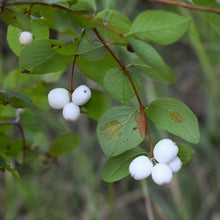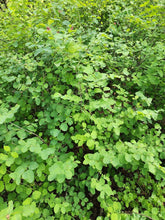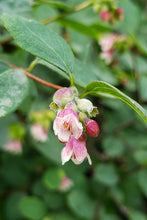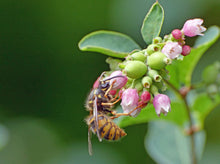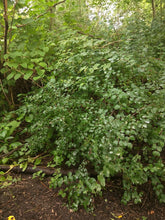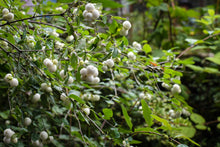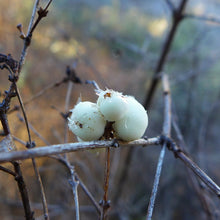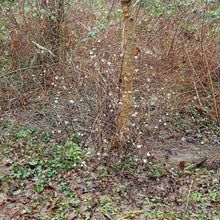
Symphoricarpos albus
There's ample reason why nearly every northwest native garden boasts this attractive shrub; it's hardy and fast-growing but not too big, great for pollinators and wildlife, and can thrive nearly anywhere! In spring and early summer, tiny, tubular white-to-pink flowers brightly punctuate branch tips, beckoning both hummingbirds and insect pollinators. True to its name, in winter, the branches droop with showy snow-white berries that are eaten by wildlife as a last resort, thereby providing visual interest in the winter garden. Interestingly, its bluish-green leaves vary widely in size and shape from plant to plant, depending on the local conditions.
- Plant type/canopy layer: deciduous, medium shrub
- Size at maturity: 3-6' tall, 6-13' wide
- Light requirements: full sun, part sun/part shade, full shade
- Moisture requirements: dry to moist soil, tolerates seasonally wet and heavy soils
- Bloom time: May - August (April - June in the Portland Metro area)
- Growth rate/ease: fast growing, easy to grow
- Wildlife support: flowers attract and provide nectar to hummingbirds, adult butterflies, bees and other insect pollinators; berries provide critical late season food for many birds and mammals including grouse, grosbeaks, robins, thrushes and bears; branches and foliage provide an important browsing opportunity for deer, antelope, and Bighorn Sheep and good cover and nesting sites for gamebirds, rabbits, and other small animals; overall plant is a caterpillar host and larval food source for several species of native butterflies and moths, including the Sphinx Moth, and also attracts/supports beneficial and other pest eating insects
- Native habitat/range: common in dry to moist open forests, clearings, and rocky slopes from southeast Alaska to southern California; all across the northern United States and the Canadian provinces. Portland Plant List - yes.
- Special features & uses: wildlife favorite; drought-tolerant; snowberries are high in saponins, which are toxic to the human body when consumed raw but have been very useful for tens of thousands of years including as shampoo and antiperspirant and medicinally to treat burns, warts, rashes and sores; infusions and teas have other abundant medicinal uses; landscape uses include pollinator gardens, rock gardens and woodland gardens and for erosion control on slopes and riparian areas
Gardening with Snowberry: Snowberry can be exceptionally ornamental in woodland gardens, with light, twiggy branches that add levity and contrast in the understory. It is also exceptionally versatile and resilient, tolerating almost any PNW garden condition, including heavy and low-nutrient soils, as well as the dreaded dry-shade. As with many species, the more sunlight it receives, the more soil moisture it prefers - and the more moisture it receives, the more vigorously it spreads. So be sure to plant the right plant in the right place based on your priorities. It also is great for controlling erosion on slopes and along riparian areas, making it essential for restoration and reclamation projects.
Try it in the feathery understory of hemlock and/or western red cedar, where it pairs nicely with the thick evergreen leaves of low Oregon grape and salal. Surround with native groundcovers like false lily of the valley and so many other lily family lovelies.
Photo Credit 1: Nikkie West, Sparrowhawk Native Plants
Photo Credit 2 (foliage): © audrey, some rights reserved (CC-BY-NC)
Photo Credit 3: Photo Credit 2: Tara Lemezis, Tiny Seed Photography
Photo Credit 3 (flowers, close): © Rupert Clayton, some rights reserved (CC-BY)
Photo Credit 4: "Wespe an Gewöhnliche Schneebeere (Symphoricarpos albus)" by Rolf Dietrich Brecher is licensed under CC BY 2.0.
Photo Credit 5: "Symphoricarpos albus (36645954286)" by Donald Hobern from Copenhagen, Denmark is licensed under CC BY 2.0.
Photo Credit 7 (frozen fruit): © icosahedron, some rights reserved (CC-BY)
Photo Credit 8 (winter look): © giantcicada, some rights reserved (CC-BY)








